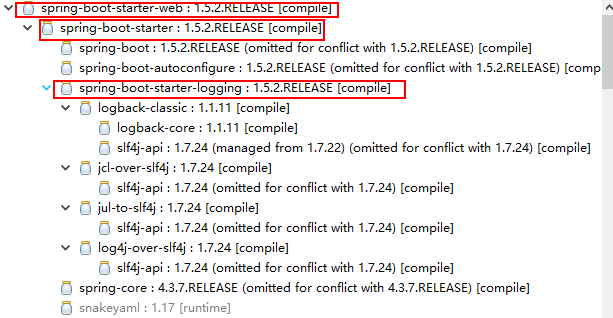作者:try | 来源:互联网 | 2023-10-12 10:31
Springboot的日志管理springboot无需引入日志的包,springboot默认已经依赖了slf4j、logback、log4j等日志。我习惯用slf4j,下面就用sl
==============Springboot的日志管理=============
springboot无需引入日志的包,springboot默认已经依赖了slf4j、logback、log4j等日志。我习惯用slf4j,下面就用slf4j做配置。
如果你导入了spring-boot-starter-web,这个会自动依赖上述日志。如下依赖:

0.日志测试类:
package daoTest;
import org.junit.Test;
import org.junit.runner.RunWith;
import org.slf4j.Logger;
import org.slf4j.LoggerFactory;
import org.springframework.boot.test.context.SpringBootTest;
import org.springframework.test.context.junit4.SpringRunner;
import cn.qlq.MySpringBootApplication;
@RunWith(SpringRunner.class)
@SpringBootTest(classes = MySpringBootApplication.class)
public class PlainTest {
private static final Logger logger = LoggerFactory.getLogger(PlainTest.class);
@Test
public void findAll() {
logger.error("error , msg->{} ", "错误");
logger.info("info , msg->{} ", "信息");
}
}
1.springboot默认的日志级别是debug

2.如果需要修改日志的相关配置可以修改applications.properties文件
############################################################
#
# 日志相关配置(默认集成的有slf4j,Logback等)
#
############################################################
#指定配置文件的位置,只能是xml或者groovy结尾
#logging.cOnfig=classpath:logback.xml
#默认的日志级别
logging.level.root=INFO
# mapper 接口所在的包设置为 debug
logging.level.cn.qlq.mapper=DEBUG
#生成日志文件的位置
logging.file=G:/springboot.log
#生成日志文件的目录,名称默认为spring.log
#logging.path=e:/
#指定日志的格式
#logging.pattern.cOnsole=%d{yyyy/MM/dd-HH:mm:ss} [%thread] %-5level %clr(%logger){cyan} %clr(%msg%n){green}
#logging.pattern.file=%d{yyyy/MM/dd-HH:mm} [%thread] %-5level %logger- %msg%n
解释:上面logging.level.root可以指定所以包默认的日志级别,logging.level.cn.qlq.mapper是对单独的子包设定日志级别,其级别可低于上面的root,也可以高于root
logging.file是指定文件日志的输出位置以及名称,logging.path是指定日志文件的位置,默认名称是spring.log(如果两者都配置以logging.file生效)
最后面是指定控制台和输出文件的日志格式。
logging.config是指定配置文件的位置,只能是xml或者groovy结尾。
关于日志级别等大致相同,参考:https://www.cnblogs.com/qlqwjy/p/9275415.html
==============Springboot整合Junit测试=============
Springboot中我们也可以像在普通的SSM环境中进行SpringJunit测试。
1.引入测试需要的模块
org.springframework.boot
spring-boot-starter-test
test
2.建立测试目录,一般在src/test/java下面和src/test/resources目录下
mapper文件和配置文件要复制到src/test/resources目录下。

3.建立测试类进行测试
SpringBootTest的classes是springboot项目启动的运行类,也就是带有@SpringBootApplication的类。
package daoTest;
import java.util.List;
import org.junit.Test;
import org.junit.runner.RunWith;
import org.springframework.beans.factory.annotation.Autowired;
import org.springframework.boot.test.context.SpringBootTest;
import org.springframework.test.context.junit4.SpringRunner;
import cn.qlq.MySpringBootApplication;
import cn.qlq.bean.User;
import cn.qlq.mapper.UserMapper;
@RunWith(SpringRunner.class)
@SpringBootTest(classes = MySpringBootApplication.class)
public class PlainTest {
@Autowired
private UserMapper userMapper;
@Test
public void findAll() {
List findAll = userMapper.findAll();
System.out.println(findAll);
}
}
==============Springboot的AOP整合=============
springboot整合Aop非常简单,只用引入AOP模块的依赖即可。然后就可以使用注解AOP。
<dependency>
<groupId>org.springframework.bootgroupId>
<artifactId>spring-boot-starter-aopartifactId>
dependency>
1.AOP的第一种切入方式:基于切点表达式进行拦截
如下记录servcice层的所有方法的执行时间的AOP写法
package cn.qlq.aspect;
import org.aspectj.lang.JoinPoint;
import org.aspectj.lang.ProceedingJoinPoint;
import org.aspectj.lang.annotation.Around;
import org.aspectj.lang.annotation.Aspect;
import org.aspectj.lang.annotation.Before;
import org.aspectj.lang.annotation.Pointcut;
import org.slf4j.Logger;
import org.slf4j.LoggerFactory;
import org.springframework.stereotype.Component;
/**
* 记录service层执行时间的AOP切面
*
* @author QiaoLiQiang
* @time 2019年2月21日下午9:20:15
*/
@Aspect
@Component
public class LogServiceTakeTime {
private final static Logger log = LoggerFactory.getLogger(LogServiceTakeTime.class);
@Pointcut("execution(* cn.qlq.service..*.*(..))")
public void performance() {
}
/**
* 环绕通知记录时间
*
* @param joinPoint
* @return
* @throws Throwable
*/
@Around("performance()")
public Object doLog(ProceedingJoinPoint joinPoint) throws Throwable {
// 记录起始时间
long begin = System.currentTimeMillis();
Object result = "";
/** 执行目标方法 */
try {
result = joinPoint.proceed();
} catch (Exception e) {
log.error("日志记录发生错误, errorMessage: {}", e.getMessage());
} finally {
/** 记录操作时间 */
long took = (System.currentTimeMillis() - begin) / 1000;
log.info("Service执行时间为: {}秒", took);
}
return result;
}
/**
* 前置通知
*
* @param joinPoint
* @throws Throwable
*/
@Before("performance()")
public void doBefore(JoinPoint joinPoint) throws Throwable {
// 接收到请求,记录请求内容
log.info("doBefore");
}
}
2.第二种切入方式:基于注解
(1)编写注解
package cn.qlq.annotation;
import java.lang.annotation.ElementType;
import java.lang.annotation.Retention;
import java.lang.annotation.RetentionPolicy;
import java.lang.annotation.Target;
/**
* 自定义注解
*
* @author QiaoLiQiang
* @time 2019年2月21日下午9:45:17
*/
@Target(ElementType.METHOD)
@Retention(RetentionPolicy.RUNTIME)
public @interface MyLogAnnotation {
String operateDescription();// 记录日志的操作类型,不写默认值就是一个必须填的注解
}
(2)编写切面进行拦截:一般在环绕通知中处理足够了
package cn.qlq.aspect;
import java.lang.reflect.Method;
import java.sql.SQLException;
import org.aspectj.lang.ProceedingJoinPoint;
import org.aspectj.lang.annotation.Around;
import org.aspectj.lang.annotation.Aspect;
import org.aspectj.lang.reflect.MethodSignature;
import org.slf4j.Logger;
import org.slf4j.LoggerFactory;
import org.springframework.stereotype.Component;
import cn.qlq.annotation.MyLogAnnotation;
/**
* @Author: qlq
* @Description 日志记录切面(拦截自定义注解进行日志记录)
* @Date: 11:46 2018/5/14
*/
@Component
@Aspect
public class MyLogAspect {
private final static Logger log = LoggerFactory.getLogger(MyLogAspect.class);
/**
* 环绕通知处理
*
* @param pjp
* @return
* @throws Throwable
*/
@Around("@annotation(cn.qlq.annotation.MyLogAnnotation)")
public Object aroundAdvice(ProceedingJoinPoint pjp) throws Throwable {
// 1.方法执行前的处理,相当于前置通知
// 获取方法签名
MethodSignature methodSignature = (MethodSignature) pjp.getSignature();
// 获取方法
Method method = methodSignature.getMethod();
// 获取方法上面的注解
MyLogAnnotation logAnno = method.getAnnotation(MyLogAnnotation.class);
// 获取到类名
String targetName = pjp.getTarget().getClass().getName();
// 获取到方法名字
String methodName = method.getName();
// 获取操作描述的属性值
String operateDescription = logAnno.operateDescription();
Object result = null;
try {
// 让代理方法执行
result = pjp.proceed();
// 2.相当于后置通知(方法成功执行之后走这里)
} catch (SQLException e) {
// 3.相当于异常通知部分
} finally {
// 4.相当于最终通知
log.info("class->{},methodName->{},operateDescription->{}", targetName, methodName, operateDescription);
}
return result;
}
}
(3)测试:

结果:

关于AOP在之前也研究过了,在这里就只研究其使用,具体的使用方法参考:https://www.cnblogs.com/qlqwjy/p/8729280.html https://www.cnblogs.com/qlqwjy/p/8747476.html